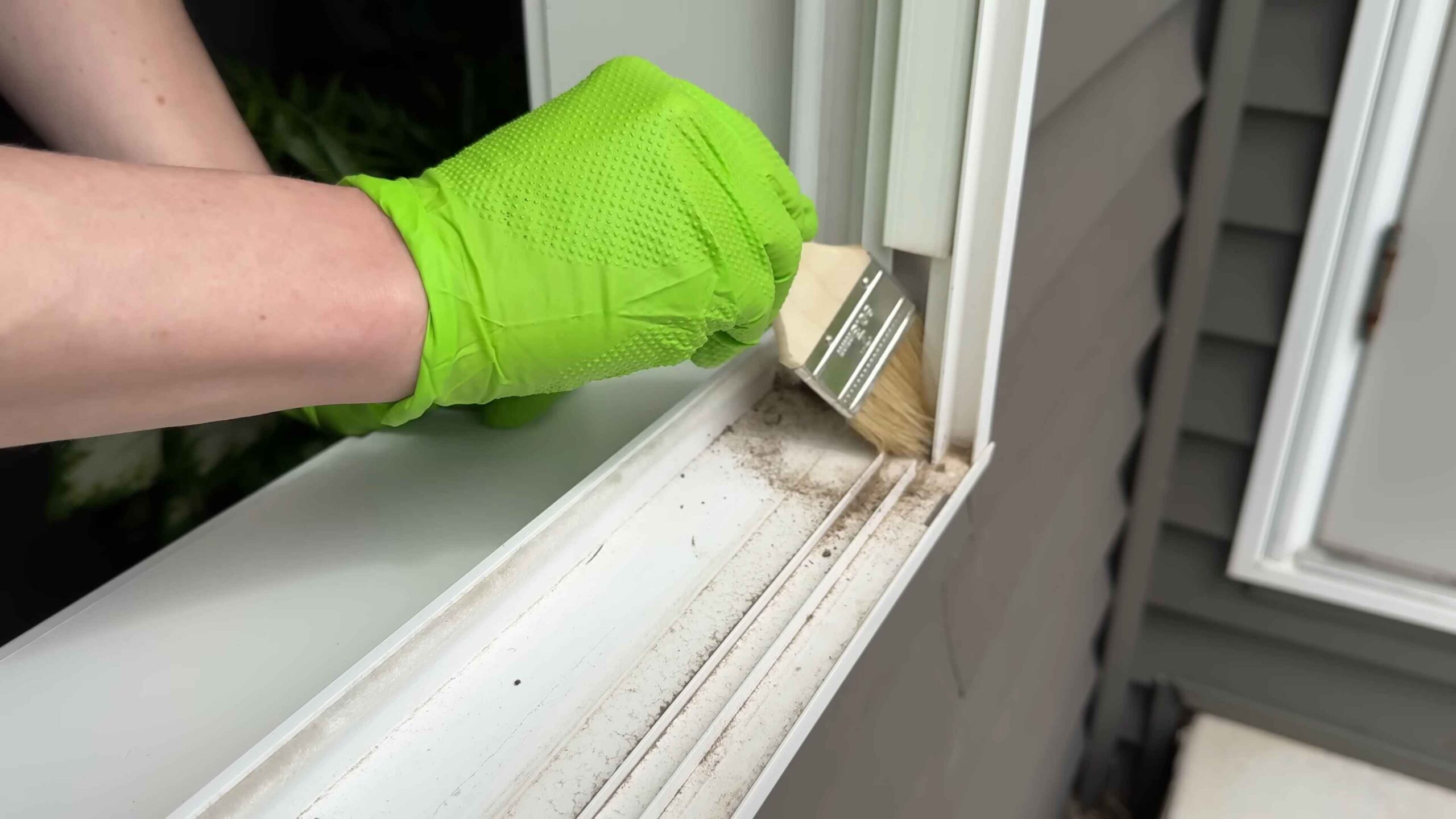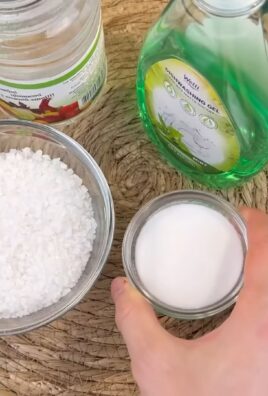Clean Window Tracks Easily? Yes, you absolutely can! Are you tired of those grimy, dusty window tracks that seem impossible to clean? I know I was! For years, I struggled with getting into those tight spaces, battling stubborn dirt and debris. It felt like a never-ending chore, and honestly, it was one I dreaded. But guess what? I’ve discovered some amazing DIY tricks that make cleaning window tracks not only easy but almost… enjoyable!
Window cleaning, in general, has a long history. Ancient civilizations used natural materials like sand and water to keep their dwellings bright. While we’ve come a long way since then, the basic principle remains the same: clean windows let in more light and improve our living spaces. But those pesky tracks? They’re a modern-day challenge!
Why is it so important to clean window tracks easily? Beyond aesthetics, dirty window tracks can actually affect your home’s air quality and even damage your windows over time. Accumulated dirt and moisture can lead to mold growth, which is definitely something you want to avoid. Plus, clean tracks allow your windows to slide smoothly, preventing unnecessary wear and tear. So, ditch the frustration and get ready to learn some simple, effective DIY hacks that will transform your window cleaning routine. Let’s get started!

Clean Window Tracks Easily: A DIY Guide
Okay, let’s face it, cleaning window tracks is one of those chores we all dread. They’re grimy, dusty, and just plain unpleasant. But don’t worry, I’m here to share my tried-and-true method for getting those tracks sparkling clean with minimal effort. Trust me, once you see how easy it is, you’ll be tackling this task more often!
What You’ll Need
Before we dive in, let’s gather our supplies. Here’s what you’ll need to make your window tracks shine:
* A vacuum cleaner with a hose attachment and a brush attachment.
* A stiff-bristled brush (an old toothbrush works great!).
* Baking soda.
* White vinegar.
* Dish soap.
* Paper towels or a clean cloth.
* A small container or bowl.
* A butter knife or putty knife (optional, for stubborn debris).
* Safety glasses (optional, but recommended).
* Gloves (optional, if you have sensitive skin).
Prepping the Area
Before we get down and dirty, let’s prep the area to make the cleaning process smoother.
1. Clear the Area: Remove any curtains, blinds, or window coverings that might get in the way. You don’t want to accidentally get them dirty!
2. Dry Vacuum: This is a crucial first step. Use your vacuum cleaner with the hose attachment and brush attachment to remove as much loose dirt, dust, and debris as possible. Pay close attention to the corners and crevices. This will prevent you from just smearing the dirt around when you start cleaning with liquids.
3. Assess the Situation: Take a good look at your window tracks. Are they just dusty, or are they caked with grime and mildew? This will help you determine how much elbow grease you’ll need to apply.
The Baking Soda and Vinegar Magic
This is where the real cleaning power comes in! The combination of baking soda and vinegar creates a fizzing action that helps to loosen dirt and grime.
1. Sprinkle Baking Soda: Generously sprinkle baking soda all over the window tracks. Make sure you get it into all the nooks and crannies. Don’t be shy!
2. Drizzle Vinegar: Slowly pour white vinegar over the baking soda. You’ll see it start to fizz and bubble. This is exactly what we want! The fizzing action helps to break down the dirt and grime.
3. Let it Fizz: Allow the baking soda and vinegar mixture to fizz for about 5-10 minutes. This gives it time to work its magic. The longer you let it sit, the better it will work, especially if you have really stubborn grime.
4. Scrub-a-dub-dub: Using your stiff-bristled brush (that old toothbrush!), scrub the window tracks thoroughly. Pay close attention to the corners and any areas with stubborn grime. The baking soda and vinegar mixture should have loosened most of the dirt, making it easier to scrub away.
5. Tackle Stubborn Spots: If you encounter any particularly stubborn spots, use a butter knife or putty knife to gently scrape away the grime. Be careful not to scratch the window tracks! I usually wrap the tip of the knife in a paper towel to prevent scratches.
Rinsing and Cleaning
Now that we’ve loosened all the dirt and grime, it’s time to rinse and clean the window tracks.
1. Prepare a Cleaning Solution: In a small container or bowl, mix a few drops of dish soap with warm water.
2. Dip and Wipe: Dip a paper towel or clean cloth into the soapy water and wring out the excess.
3. Wipe Down the Tracks: Thoroughly wipe down the window tracks with the damp cloth, removing all traces of the baking soda, vinegar, and loosened dirt. You may need to repeat this step several times to get the tracks completely clean.
4. Rinse (Optional): If you want to be extra thorough, you can rinse the window tracks with clean water. Just be careful not to get water everywhere! I usually use a spray bottle filled with water and then immediately wipe it up with a clean cloth.
5. Dry Thoroughly: This is important! Use a clean, dry cloth or paper towel to thoroughly dry the window tracks. This will prevent mildew from forming.
Dealing with Mold and Mildew
Sometimes, window tracks can develop mold or mildew, especially in humid environments. If you find mold or mildew in your window tracks, here’s how to deal with it:
1. Safety First: Wear safety glasses and gloves to protect yourself from the mold spores.
2. Vinegar Power: Spray the moldy areas with undiluted white vinegar. Vinegar is a natural disinfectant and can kill mold and mildew.
3. Let it Sit: Allow the vinegar to sit on the moldy areas for at least 30 minutes.
4. Scrub and Wipe: Scrub the moldy areas with your stiff-bristled brush and then wipe them clean with a damp cloth.
5. Repeat if Necessary: If the mold or mildew is particularly stubborn, you may need to repeat this process several times.
6. Dry Thoroughly: Again, make sure to dry the window tracks thoroughly to prevent the mold or mildew from returning.
Preventative Measures
Now that your window tracks are sparkling clean, let’s talk about how to keep them that way!
* Regular Vacuuming: Vacuum your window tracks regularly (at least once a month) to remove loose dirt and dust. This will prevent grime from building up.
* Wipe Up Spills Immediately: If you spill anything in your window tracks, wipe it up immediately. This will prevent stains and grime from forming.
* Improve Ventilation: Make sure your home is well-ventilated to prevent moisture buildup, which can lead to mold and mildew.
* Consider a Window Track Brush: There are specialized window track brushes available that are designed to reach into the narrow crevices of window tracks. These can be a great investment for keeping your window tracks clean.
Extra Tips and Tricks
Here are a few extra tips and tricks that I’ve learned over the years:
* Use a Cotton Swab: For those really hard-to-reach corners, use a cotton swab dipped in vinegar or soapy water to clean them out.
* Magic Eraser: A Magic Eraser can be surprisingly effective at removing stubborn stains and grime from window tracks. Just be careful not to scratch the surface.
* Steam Cleaner: If you have a steam cleaner, you can use it to blast away dirt and grime from your window tracks. This is a great option for deep cleaning.
* WD-40: For sticky or squeaky window tracks, try spraying a little WD-40 on the tracks. This can help to lubricate them and make them easier to open and close.
Breaking it Down: A Quick Recap
Just to make sure we’re all on the same page, here’s a quick recap of the steps:
* Step 1: Prep the Area: Clear the area and vacuum the window tracks.
* Step 2: Baking Soda and Vinegar: Sprinkle baking soda, drizzle vinegar, let it fizz, and scrub.
* Step 3: Rinse and Clean: Prepare a cleaning solution, wipe down the tracks, and dry thoroughly.
* Step 4: Mold and Mildew (If Necessary): Spray with vinegar, let it sit, scrub, and dry.
* Step 5: Preventative Measures: Vacuum regularly, wipe up spills, and improve ventilation.
Why This Method Works
You might be wondering why this method is so effective. Well, it’s all about the combination of ingredients and techniques.
* Baking Soda: Baking soda is a mild abrasive that helps to scrub away dirt and grime without scratching the surface. It’s also a natural deodorizer.
* Vinegar: Vinegar is a natural acid that helps to dissolve dirt, grime, and mineral deposits. It’s also a disinfectant and can kill mold and mildew.
* Fizzing Action: The fizzing action of the baking soda and vinegar helps to loosen dirt and grime, making it easier to scrub away.
* Stiff-Bristled Brush: A stiff-bristled brush is essential for getting into the narrow crevices of window tracks and scrubbing away stubborn grime.
* Thorough Drying: Thorough drying is crucial for preventing mildew from forming.
Final Thoughts
Cleaning window tracks may not be the most glamorous chore, but it’s definitely worth doing. Clean window tracks not only look better, but they also help to improve the air quality in your home. Plus, it’s just satisfying to see those grimy tracks transformed into sparkling clean surfaces. So, grab your supplies and get to work! You’ll be amazed at the difference

Conclusion
So, there you have it! Cleaning window tracks might seem like a daunting chore, but with this simple DIY trick, it becomes a breeze. Forget spending hours scrubbing with harsh chemicals and specialized tools. This method is not only incredibly effective at removing stubborn dirt, grime, and even mold, but it’s also budget-friendly and uses ingredients you likely already have in your home.
Why is this DIY window track cleaning method a must-try? Because it saves you time, money, and effort while delivering sparkling clean results. Imagine the satisfaction of opening and closing your windows smoothly, free from the grating sound of debris. Think of the improved air quality in your home, free from the dust and allergens that accumulate in dirty window tracks. And consider the overall aesthetic improvement – clean window tracks instantly make your windows look newer and brighter, enhancing the appearance of your entire room.
But don’t just take our word for it! We encourage you to experiment and personalize this method to suit your specific needs. For instance, if you’re dealing with particularly stubborn mold or mildew, you can add a few drops of tea tree oil to your cleaning solution for its natural antifungal properties. If you prefer a more abrasive scrub, try using an old toothbrush with stiffer bristles. And if you want to add a pleasant scent, a few drops of your favorite essential oil will do the trick.
This DIY window track cleaning solution is also incredibly versatile. It works wonders on sliding door tracks, shower door tracks, and even the tracks of your car windows. So, once you’ve mastered the technique, you can apply it to various areas of your home and vehicle.
We’re confident that once you try this DIY window track cleaning method, you’ll never go back to your old ways. It’s a game-changer that will transform your cleaning routine and leave you with sparkling clean window tracks in no time.
Now, it’s your turn! Give this DIY trick a try and share your experience with us. Let us know what variations you tried, what challenges you encountered, and what results you achieved. We’re eager to hear your feedback and learn from your experiences. Share your before-and-after photos on social media using #CleanWindowTracksDIY and inspire others to embrace this simple yet effective cleaning solution. Together, we can make window track cleaning a less dreaded chore and a more rewarding experience.
Don’t delay, grab your supplies, and get ready to transform your window tracks from grimy to gleaming. You’ll be amazed at the difference it makes!
Frequently Asked Questions (FAQ)
What exactly is the benefit of cleaning my window tracks regularly?
Regularly cleaning your window tracks offers a multitude of benefits. Firstly, it improves the functionality of your windows. Accumulated dirt and debris can hinder smooth opening and closing, putting strain on the window mechanism and potentially leading to costly repairs. Secondly, clean window tracks contribute to better indoor air quality. Dust, pollen, and mold spores trapped in the tracks can become airborne, triggering allergies and respiratory problems. Thirdly, clean window tracks enhance the overall aesthetic appeal of your home. Grimy tracks detract from the appearance of your windows and the room as a whole. Finally, regular cleaning prevents the buildup of stubborn grime, making future cleaning tasks much easier.
How often should I clean my window tracks?
The frequency of cleaning depends on several factors, including your location, the amount of traffic near your windows, and the presence of pets. As a general guideline, aim to clean your window tracks at least twice a year, ideally in the spring and fall. However, if you live in a dusty area, have pets that shed frequently, or notice a significant buildup of dirt and debris, you may need to clean them more often, perhaps once a month or every other month.
What kind of cleaning solution is best for window tracks?
The best cleaning solution for window tracks is often a simple mixture of household ingredients. A solution of warm water and dish soap is effective for removing most dirt and grime. For tougher stains or mold, you can use a mixture of equal parts white vinegar and water. Baking soda paste is also a great option for scrubbing away stubborn debris. Avoid using harsh chemicals or abrasive cleaners, as they can damage the window tracks and surrounding surfaces. Always test any cleaning solution in an inconspicuous area first to ensure it doesn’t cause discoloration or damage.
What tools do I need to clean window tracks effectively?
You don’t need fancy or expensive tools to clean window tracks effectively. Here’s a list of essential tools:
* A vacuum cleaner with a crevice tool attachment: This is essential for removing loose dirt and debris before you start cleaning.
* A small brush, such as an old toothbrush or a specialized window track cleaning brush: This is used for scrubbing away stubborn grime.
* A microfiber cloth or sponge: This is used for wiping down the tracks and removing excess cleaning solution.
* Cotton swabs: These are useful for cleaning hard-to-reach areas and corners.
* A putty knife or similar tool: Wrapped in a cloth, this can help dislodge stubborn debris.
* Spray bottle: For applying your cleaning solution.
* Gloves: To protect your hands.
Can I use bleach to clean mold in window tracks?
While bleach is effective at killing mold, it’s not always the best option for cleaning window tracks. Bleach can be harsh and corrosive, potentially damaging the window tracks and surrounding surfaces. It can also release harmful fumes. If you choose to use bleach, dilute it properly with water (follow the manufacturer’s instructions) and wear gloves and eye protection. Ensure adequate ventilation and avoid mixing bleach with other cleaning products, as this can create toxic fumes. A safer and often equally effective alternative is to use a mixture of white vinegar and water. Vinegar is a natural disinfectant and mold killer that is less harsh than bleach.
How do I prevent window tracks from getting dirty in the first place?
Preventing window tracks from getting dirty is easier than cleaning them after they’ve accumulated a lot of grime. Here are some tips to help keep your window tracks clean:
* Vacuum your window tracks regularly: This will remove loose dirt and debris before they have a chance to accumulate.
* Wipe down your window tracks after rain or storms: This will prevent water stains and mold growth.
* Apply a silicone-based lubricant to your window tracks: This will help prevent dirt and debris from sticking to the tracks.
* Use weather stripping to seal gaps around your windows: This will prevent dust and pollen from entering your home.
* Trim bushes and trees near your windows: This will reduce the amount of debris that falls into your window tracks.
What if my window tracks are severely rusted?
If your window tracks are severely rusted, cleaning them may not be enough to restore them to their original condition. In this case, you may need to consider replacing the window tracks. However, before you do that, you can try using a rust remover specifically designed for metal surfaces. Follow the manufacturer’s instructions carefully and wear gloves and eye protection. After removing the rust, you can apply a rust-inhibiting primer and paint to protect the tracks from further corrosion. If the rust is too extensive or the tracks are damaged beyond repair, replacing them may be the only option.
Is it safe to use a pressure washer to clean window tracks?
Using a pressure washer to clean window tracks is generally not recommended. The high pressure can damage the window tracks, seals, and surrounding surfaces. It can also force water into the walls and cause mold growth. If you must use a pressure washer, use a low-pressure setting and a wide nozzle. Keep the nozzle at a safe distance from the window tracks and avoid spraying directly at the seals. However, it’s always best to use a gentler cleaning method to avoid any potential damage.





Leave a Comment